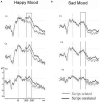Context effects in language comprehension: The role of emotional state and attention on semantic and syntactic processing
- PMID: 36504628
- PMCID: PMC9732474
- DOI: 10.3389/fnhum.2022.1014547
Context effects in language comprehension: The role of emotional state and attention on semantic and syntactic processing
Abstract
Semantics and syntax are core components of language. The prevailing view was that processing of word meaning and syntactic processing happens in isolation from other systems. In light of proofed interactions between language and other systems, especially with perception, action and emotion, this view became untenable. This article reviews Event-related potential studies conducted at the Donders Centre for Cognition exploring the interplay between language comprehension and a person's emotional state. The research program was aimed at an investigation of the online effects of emotional state on semantic processing and syntactic processing. To this aim we manipulated mood via film fragments (happy vs. sad) before participants read neutral sentences while their EEG was recorded. In Part 1, it is shown that mood impacts online semantic processing (as indicated by N400) and the processing of syntactic violations (as indicated by P600). Part 2 was directed at a further determination of the mechanisms underlying these interactions. The role of heuristics was examined by investigating the effects of mood on the P600 to semantic reversals. The results revealed that mood affects heuristic processing. The next step consisted of an assessment of the role of attention, in the mood-by-semantics and mood-by-syntax interaction. This was accomplished by recording EEG while manipulating attention via task next to emotional state. Participants performed a semantic or syntactic judgment task vs. a letter-size judgment task. The main ERP results were as follows: (i) attention interacts with the mood effect on semantic processing and syntactic processing, respectively, (ii) the effects of mood on semantic processing and syntactic processing are reliable, and (iii) the mood effects on semantic processing are not fixed but context-dependent. In Part 3 the effects of mood on the processing of script knowledge and general world knowledge are presented. Part 4 closes with a discussion of the mechanisms involved in the mood-by-language interactions and recommendations for future research. Regarding the underlying mechanism we propose that heuristics based on semantic expectancies or syntactic expectancies play a key role in the mood-by-language interactions. The results support the view that language takes place in continuous interaction with other (non-language) systems.
Keywords: N400 cloze effect; P600 effect; abstract symbol theories; attention; embodied theories; emotion; heuristic processing; language comprehension.
Copyright © 2022 Chwilla.
Conflict of interest statement
The author declares that the research was conducted in the absence of any commercial or financial relationships that could be construed as a potential conflict of interest.
Figures












Similar articles
-
Contributions of emotional state and attention to the processing of syntactic agreement errors: evidence from P600.Front Psychol. 2015 Apr 9;6:388. doi: 10.3389/fpsyg.2015.00388. eCollection 2015. Front Psychol. 2015. PMID: 25914660 Free PMC article.
-
The interplay between mood and language comprehension: evidence from P600 to semantic reversal anomalies.Neuropsychologia. 2013 May;51(6):1027-39. doi: 10.1016/j.neuropsychologia.2013.02.007. Epub 2013 Feb 27. Neuropsychologia. 2013. PMID: 23454263
-
The relationship of language and emotion: N400 support for an embodied view of language comprehension.J Cogn Neurosci. 2011 Sep;23(9):2400-14. doi: 10.1162/jocn.2010.21578. Epub 2010 Sep 17. J Cogn Neurosci. 2011. PMID: 20849229
-
Neural mechanisms of language comprehension: challenges to syntax.Brain Res. 2007 May 18;1146:23-49. doi: 10.1016/j.brainres.2006.12.063. Epub 2006 Dec 23. Brain Res. 2007. PMID: 17400197 Review.
-
Getting real about semantic illusions: rethinking the functional role of the P600 in language comprehension.Brain Res. 2012 Mar 29;1446:127-43. doi: 10.1016/j.brainres.2012.01.055. Epub 2012 Feb 2. Brain Res. 2012. PMID: 22361114 Review.
Cited by
-
Effects of subliminal emotional facial expressions on language comprehension as revealed by event-related brain potentials.Sci Rep. 2025 Jul 1;15(1):20449. doi: 10.1038/s41598-025-06037-2. Sci Rep. 2025. PMID: 40596140 Free PMC article.
-
The cognitive science of language diversity: achievements and challenges.Cogn Process. 2025 Aug;26(3):719-736. doi: 10.1007/s10339-025-01262-z. Epub 2025 Feb 25. Cogn Process. 2025. PMID: 39998596 Free PMC article. Review.
References
-
- Anderson J. R., Matessa M., Lebiere C. (1997). ACT-R: A theory of higher level cognition and its relation to visual attention. Hum. Comput. Interact. 12 439–462. 10.1207/s15327051hci1204_5 - DOI
-
- Barlett F. C. (1932). Remembering. Cambridge: The Cambridge University Press.
Publication types
LinkOut - more resources
Full Text Sources

